Intel Xeon Gold 6148 Benchmarks
For this exercise, we are using our legacy Linux-Bench scripts which help us see cross-platform “least common denominator” results we have been using for years as well as several results from our updated Linux-Bench2 scripts. At this point, our benchmarking sessions take days to run and we are generating well over a thousand data points. We are also running workloads for software companies that want to see how their software works on the latest hardware. As a result, this is a small sample of the data we are collecting and can share publicly. Our position is always that we are happy to provide some free data but we also have services to let companies run their own workloads in our lab, such as with our DemoEval service. What we do provide is an extremely controlled environment where we know every step is exactly the same and each run is done in a real-world data center, not a test bench.
Python Linux 4.4.2 Kernel Compile Benchmark
This is one of the most requested benchmarks for STH over the past few years. The task was simple, we have a standard configuration file, the Linux 4.4.2 kernel from kernel.org, and make the standard auto-generated configuration utilizing every thread in the system. We are expressing results in terms of compiles per hour to make the results easier to read.
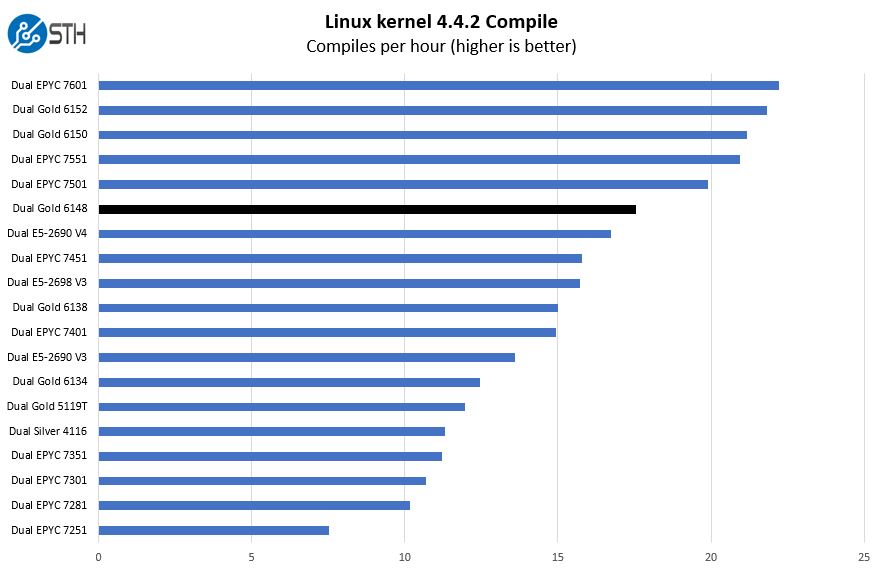
Although it may not have the same core count as its AMD EPYC competition, the fact that the Intel Xeon Gold 6148 has a quarter of the NUMA nodes and higher clock speeds put it right between the dual AMD EPYC 7501 (32 core) and dual AMD EPYC 7451 (24 core) setups. If you are looking for compute performance, the extra clock speeds throughout the range make a difference over the dual Intel Xeon Gold 6138 setup.
c-ray 1.1 Performance
We have been using c-ray for our performance testing for years now. It is a ray tracing benchmark that is extremely popular to show differences in processors under multi-threaded workloads. Since this is a larger setup, we are going to use our new Linux-Bench2 8K render to show differences.
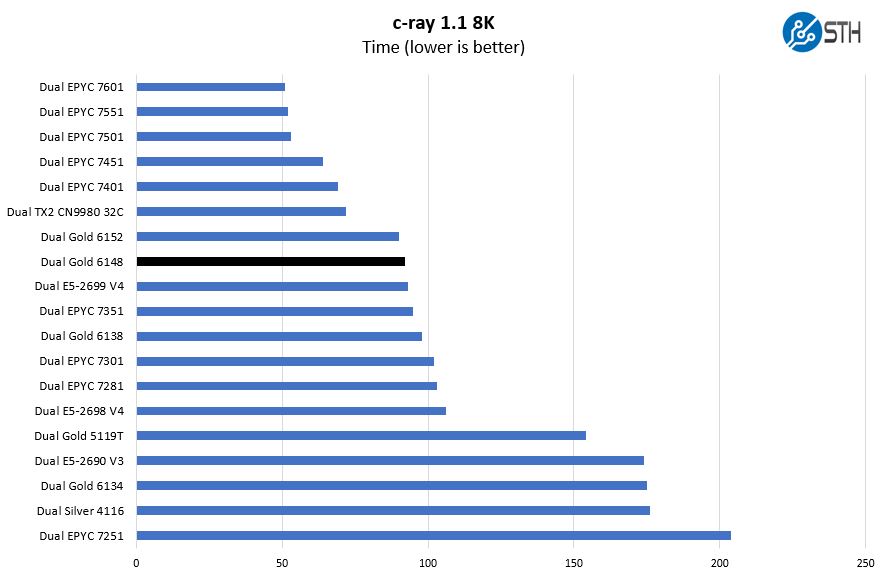
Here AMD has an architectural advantage in their core/ cache so they perform extremely well. We also added in ThunderX2 results to get a bit of the ARM HPC chip into the comparison.
7-zip Compression Performance
7-zip is a widely used compression/ decompression program that works cross-platform. We started using the program during our early days with Windows testing. It is now part of Linux-Bench.
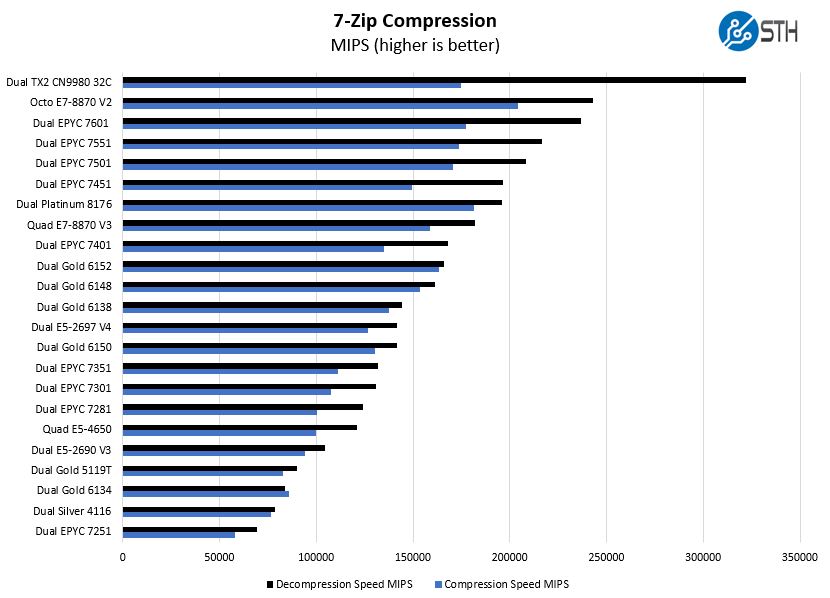
We traditionally sort this chart based on decompression speed. Since there are some large compression/ decompression deltas, and we have a wide range of hardware here, we wanted to show the compression sorted view as well.
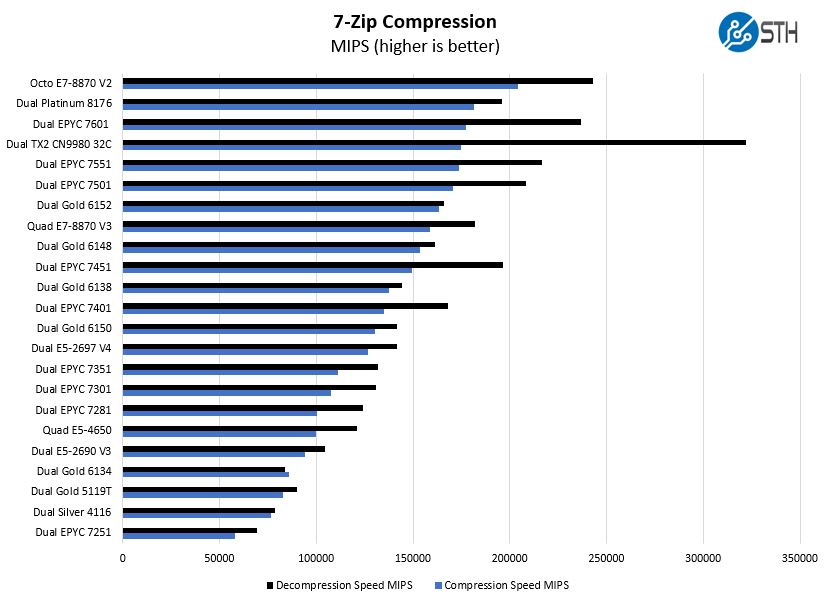
This is extremely intriguing. The dual Intel Xeon Gold 6148 is between the AMD EPYC 24 and 32 core results. ThunderX2 performs well here, as it should since that system has 64 cores and 256 threads. Perhaps the most intriguing is that the dual Intel Xeon Gold 6148 results are not too far off of the quad Intel Xeon E7-8870 V3 results. The shrink to fewer higher clocked parts with some microarchitecture improvements and fewer NUMA nodes also means that Intel is using less than half the power in this test over the quad E7 setup.
NAMD Performance
NAMD is a molecular modeling benchmark developed by the Theoretical and Computational Biophysics Group in the Beckman Institute for Advanced Science and Technology at the University of Illinois at Urbana-Champaign. More information on the benchmark can be found here. We are going to augment this with GROMACS in the next-generation Linux-Bench in the near future. With GROMACS we have been working hard to support Intel’s Skylake AVX-512 and AVX2 supporting AMD Zen architecture. Here are the comparison results for the legacy data set:
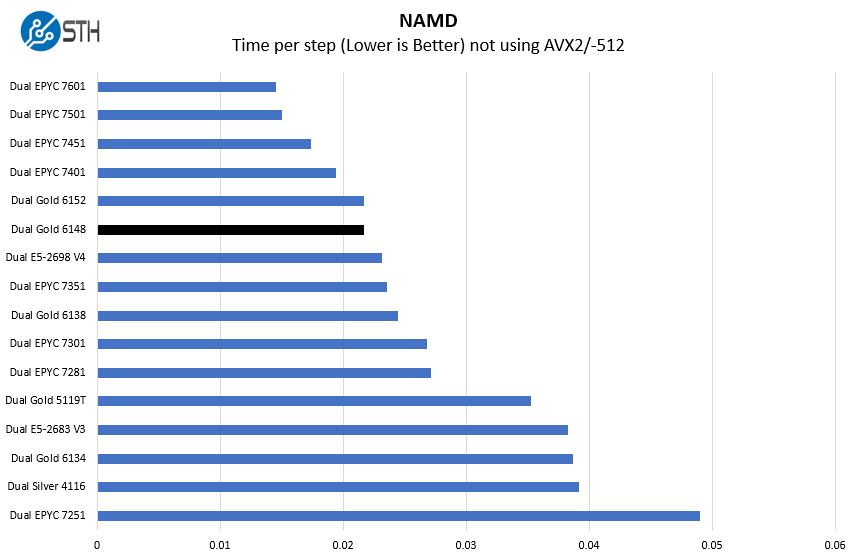
We wanted to draw attention here to the dual Intel Xeon E5-2698 V4 result. The Xeon E5-2698 V4 is the previous generation 20 core CPU. It boasts only a 2.2GHz base and 3.7GHz turbo clock and cost about 5-10% more per chip. This is a case where one gets more performance for less cost generation/ generation.
Sysbench CPU test
Sysbench is another one of those widely used Linux benchmarks. We specifically are using the CPU test, not the OLTP test that we use for some storage testing.
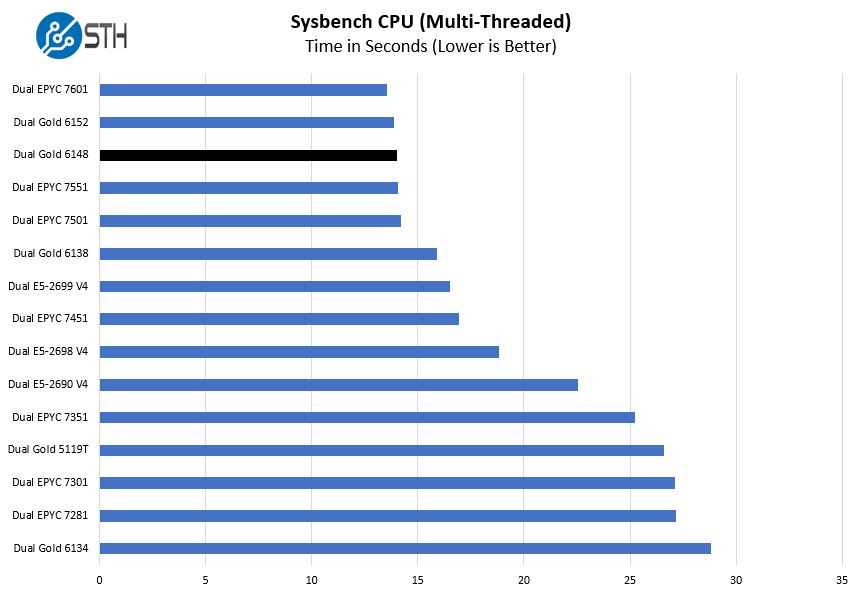
On the sysbench CPU side, we see a nice architectural gain from the Intel Xeon Scalable “Skylake-SP” architecture over the “Broadwell-EP” architecture.
OpenSSL Performance
OpenSSL is widely used to secure communications between servers. This is an important protocol in many server stacks. We first look at our sign tests:
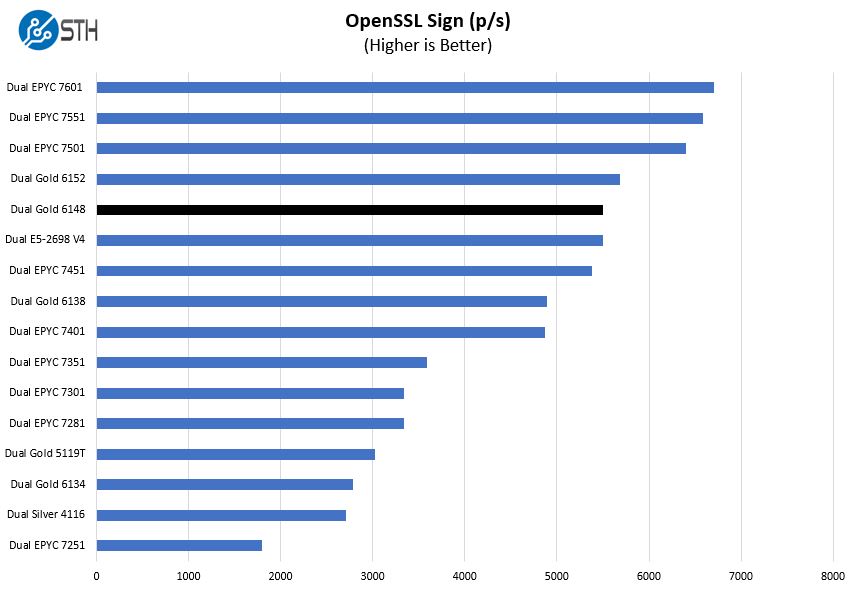
here are the verify results:
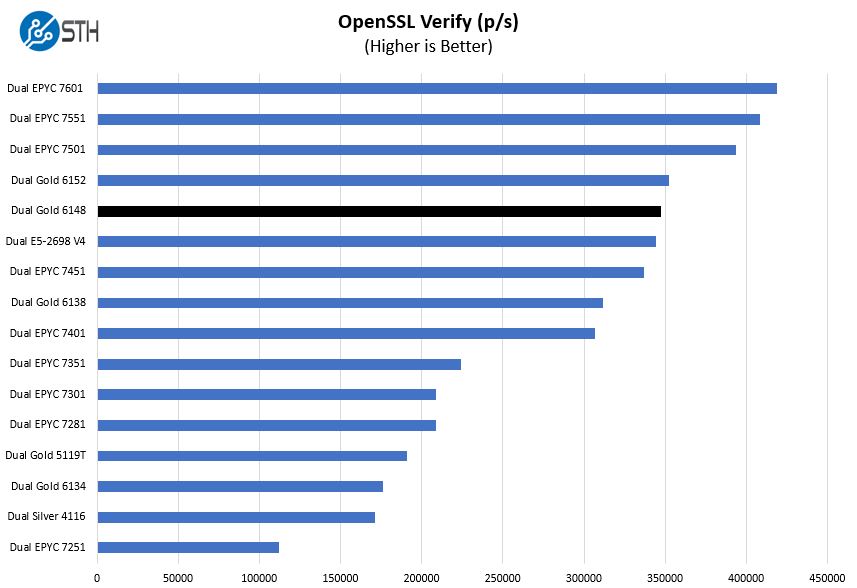
Here the 20-core Intel Xeon Gold 6148 still bests its predecessor by a narrow margin, and again at a lower cost. The chips are also doing generally better than their 24 core AMD EPYC counterparts due to clock speed and lower NUMA node counts.
UnixBench Dhrystone 2 and Whetstone Benchmarks
Some of the longest-running tests at STH are the venerable UnixBench 5.1.3 Dhrystone 2 and Whetstone results. They are certainly aging, however, we constantly get requests for them, and many angry notes when we leave them out. UnixBench is widely used so we are including it in this data set. Here are the Dhrystone 2 results:
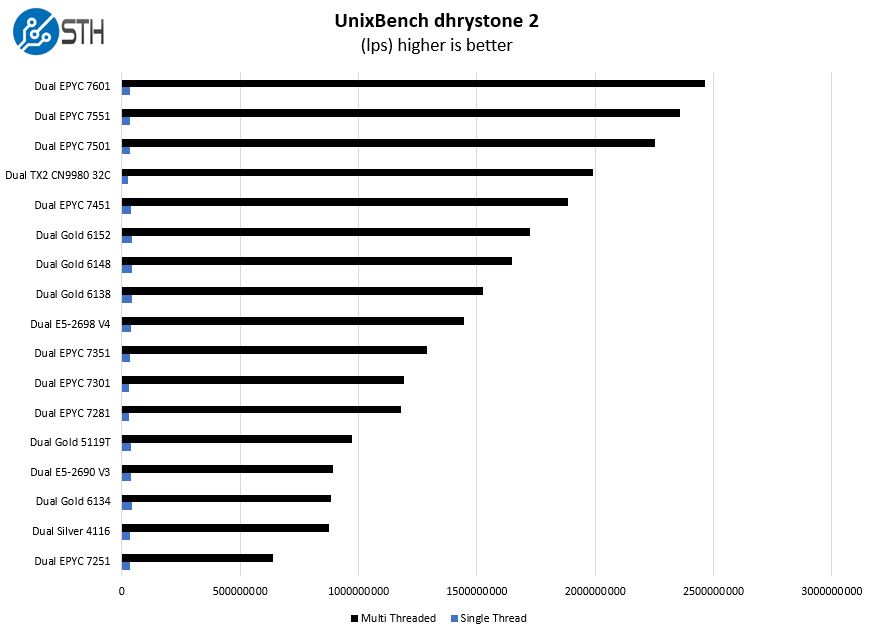
Here are the whetstone results:
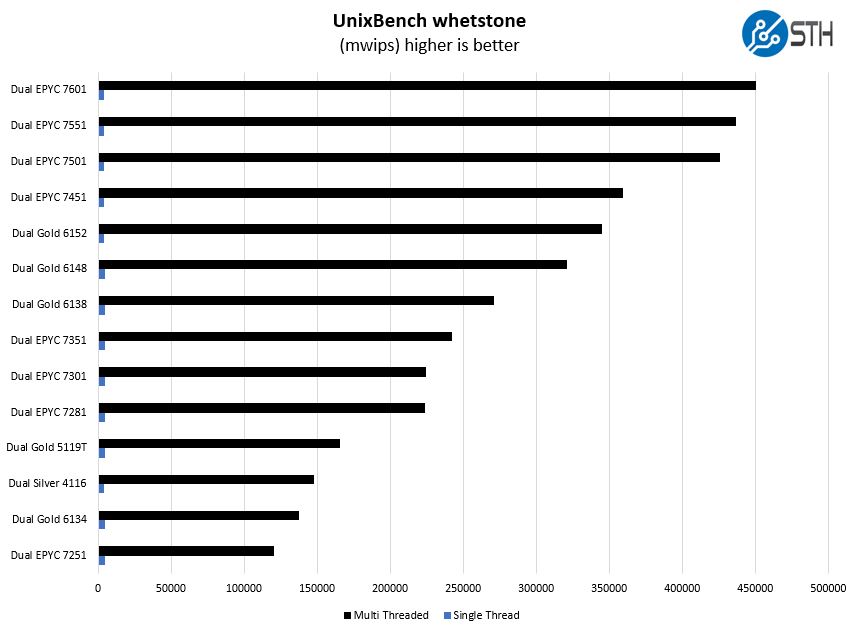
Here the Intel Xeon Gold 6148 performs well and well beyond the Xeon Gold 613x series. We removed a number of results to focus this on current generation (at the time of publication) parts and to de-clutter the charts a bit since these tend to be eye charts.
GROMACS STH Small AVX2/ AVX-512 Enabled
We have a small GROMACS molecule simulation we previewed in the first AMD EPYC 7601 Linux benchmarks piece. In Linux-Bench2 we are using a “small” test for single and dual socket capable machines. Our medium test is more appropriate for higher-end dual and quad socket machines. Our GROMACS test will use the AVX-512 and AVX2 extensions if available.
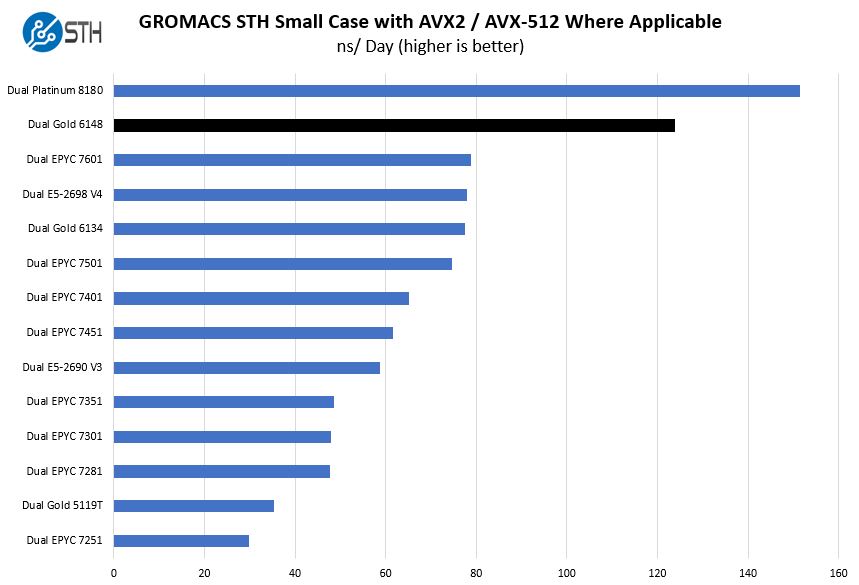
AVX-512 turbo frequencies are an interesting topic themselves. Also, as real applications have to transition from cores running AVX-512 to AVX2 or non-AVX execution, the chips have to manage clocks accordingly. Modern Intel Xeon Scalable CPUs can manage clock speeds based on the code that individual cores are running. Using AVX-512, these parts absolutely scream.
Chess Benchmarking
Chess is an interesting use case since it has almost unlimited complexity. Over the years, we have received a number of requests to bring back chess benchmarking. We have been profiling systems and are ready to start sharing results:
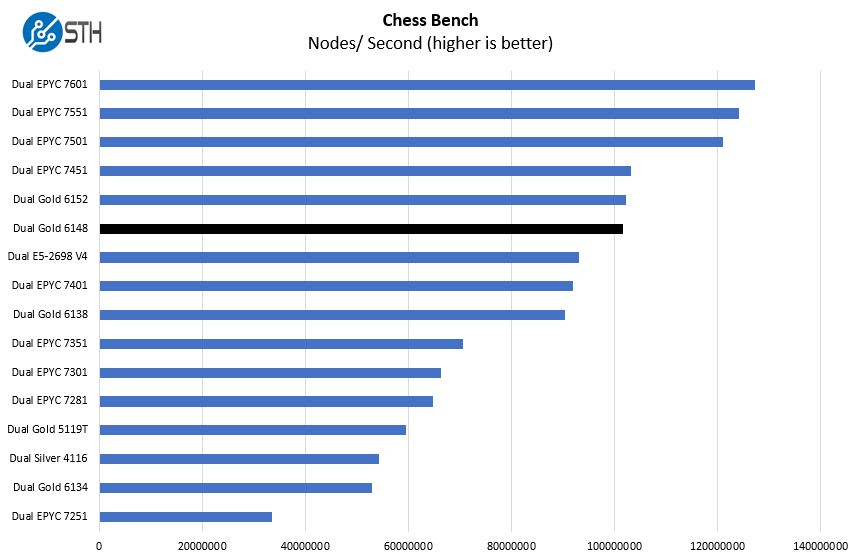
We again see a trend with Intel doing more work with fewer cores than AMD EPYC. Still, at the top end with the 32 core AMD EPYC parts, AMD has a step function additional level of performance.
Next, we are going to look at the Intel Xeon Gold 6138 power consumption along with market positioning. We will then provide our concluding thoughts on the CPUs.




I still get a kick that STH casually publishes numbers and it’s like, oh we’ve got data for an OCTO processor Xeon E7 system, the FULL AMD EPYC 2P range, there’s even some quad systems in there. Great data to see consolidation. Oh, and here’s some 100gbps OPA for you too.
Intel is competitive against EPYC with this CPU, EPYC prices are rising since intel problems (production and spectre, meltdown, foreshadow, etc…).
Do you use pure MPI or MPI+OpenMP parallel execution model in NAMD/Gromacs benchmarks?
Also interesting with OmniPath on Chip is that you still get 48 PCIe lanes from the CPU.